
Samson and Delilah when they were puppies
By William Vandry
Contents
Staphylococcus
SJMO test on my dog with Staph Dermatitis
How is Staphylococcal hypersensitivity treated on dogs?
SJMO oils reference studies using same oils on Dog rashes, infections, parasites, mites, ticks, fleas
References
Staphylococcus
Staphylococcus is a name of a group of bacteria commonly found on the skin. Dermatitis is a term that means inflammation of the skin. This condition is also referred to as Staphylococcal pyoderma or Staph. pyoderma. Pyoderma is a medical term for bacterial skin infection.
- Staph infections are caused by staph bacteria that exist on the skin of many people and animals.
- Staph bacteria lies dormant until the skin is irritated or the immune system is compromised.
- Symptoms include lesions, itching, fever, pain, and loss of appetite.
- Staph infections are usually treated with antibiotics, but the underlying cause must also be addressed. In some cases, the infection may return after treatment is completed. This situation may be the result of an allergy to the staph bacteria, called Staphylococcus hypersensitivity or Staphylococcus allergy.
This is a different disease than a staph infection, and is characterized by recurrence. Because of this, treatment for staph hypersensitivity is usually long term and involves routine injections of the staph bacteria as a way to desensitize the pet’s immune system to the bacteria. Many pets respond well to desensitization therapy, but those that do not may require long term treatment with antibiotics as well as medicated baths.
Source: https://www.petcarerx.com/article/staph-infection-in-dogs-and-cats/2858
SJMO test on my dog with Staph Dermatitis
My dog Delilah had what most dogs get. They receive doggy rashes (Staphylococcal Dermatitis) on their stomach and ear areas among others. I wipe her from head to paws each time she comes in, but at times there are bushes, plants or grass where they can still receive a reaction. I applied topically a few drops of the Miracle oil product on her stomach area lightly around the rash. The rash was not itching after a day. The rash began to subside and was under control within 2 days. We then applied it to her rash for 12 days, and these are photos of the first day and 12th:
Test 1
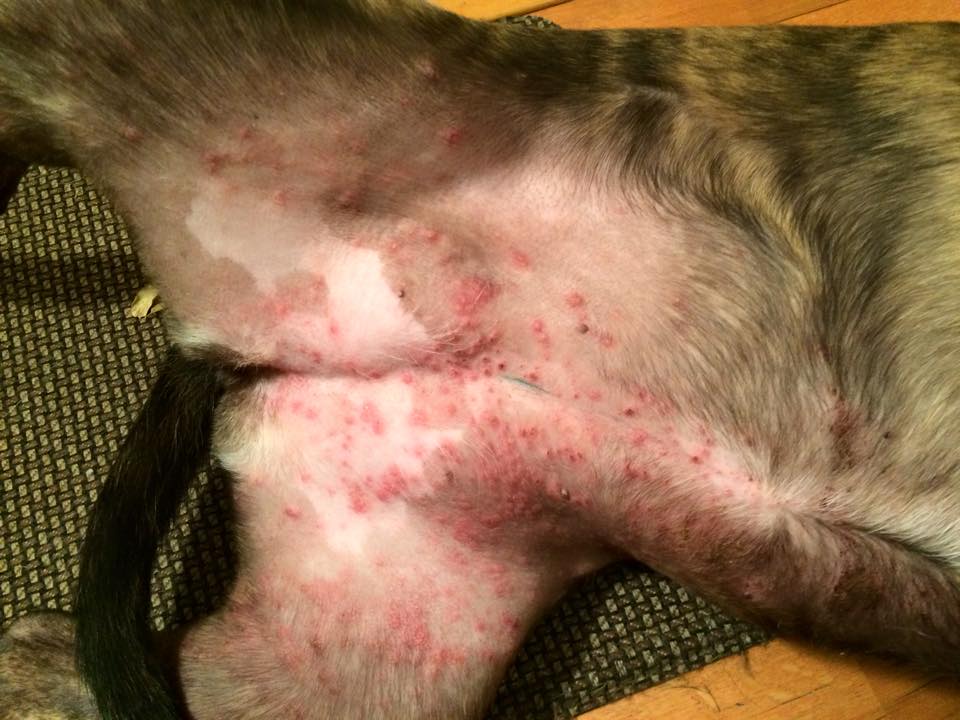
1. December 10, 2015 Delilah has staph or common dog rash
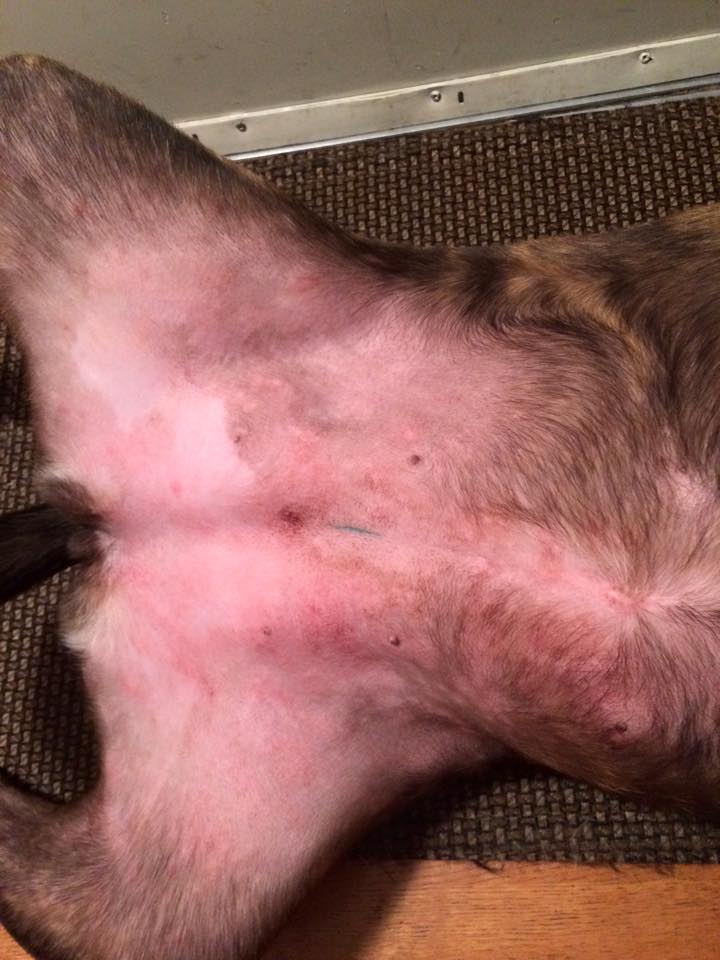
2. December 22, 2015 dog rash is gone, and as of February 9, 2016 it has not returned.
NOTE: The veterinary reference below is merely a reference to essential oils in studies. Please consult your veterinarian and do not attempt to self treat or treat dogs.
12 days, no antibiotics, no cream, just sjmo applied 1-2x day. (Not orally, and do not suggest your own trials, as essential oils can be toxic if consumed orally) Usually a vet gives an antibiotic, and I have read in the veterinarian journals that there is no cure for staph or canine rash, and you must keep maintaining the ointment up to two years.
My other dog Samson has a scrape on his paw that became aggravated when he played or ran. We applied a few drops of the SJMO directly on his paw scrape.
Test 2
- Samson’s paw due to scrape
2. Samson paw scape heals without scabbing two days later.
Test 3, Samson side scrape.
App. one day later wound has no scabbing, wound is bright pink, and even scab around fur in first photo showing darker fur has sloughed off.
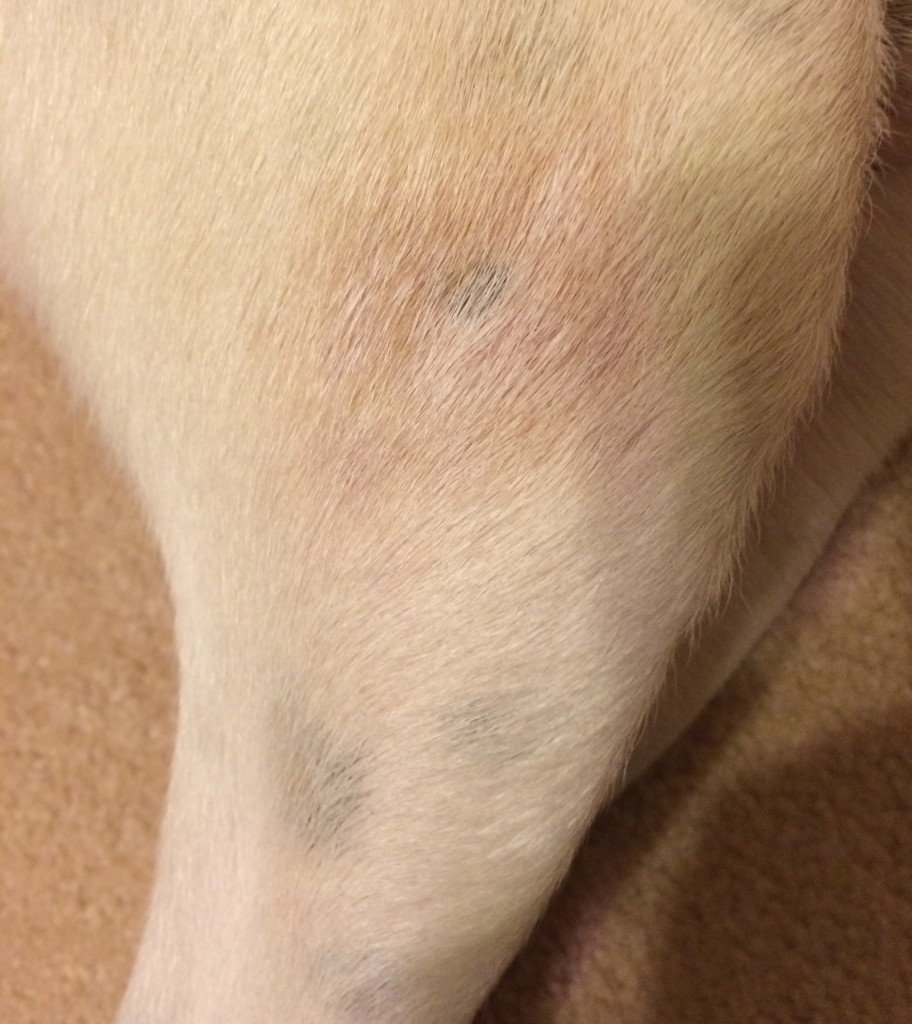
Wound is totally healed within 5 days time. Hair has grown back within app. 14 days. Note dark spot is not former wound, it is a dark patch on skin. Please read our wounds article for more information on SMO oils vs. wounds.
Test 4
Samson had also acquired the same rash as Delilah above, around same time.
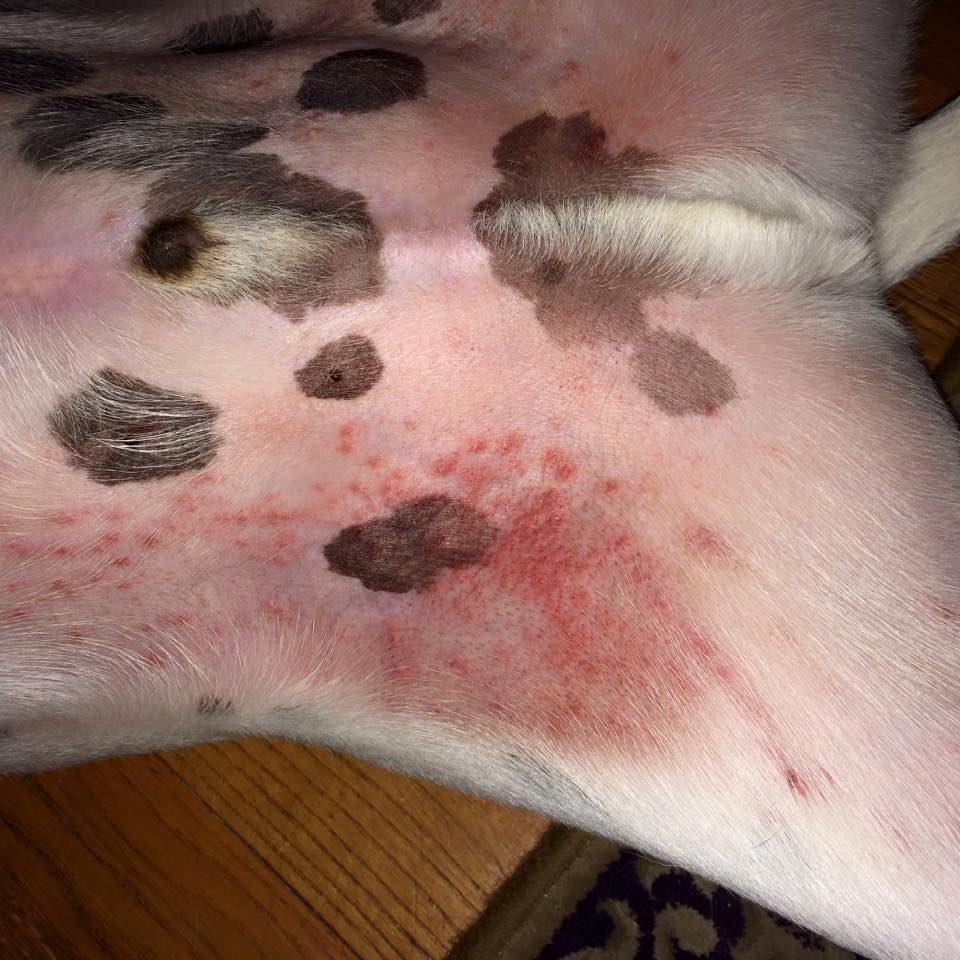
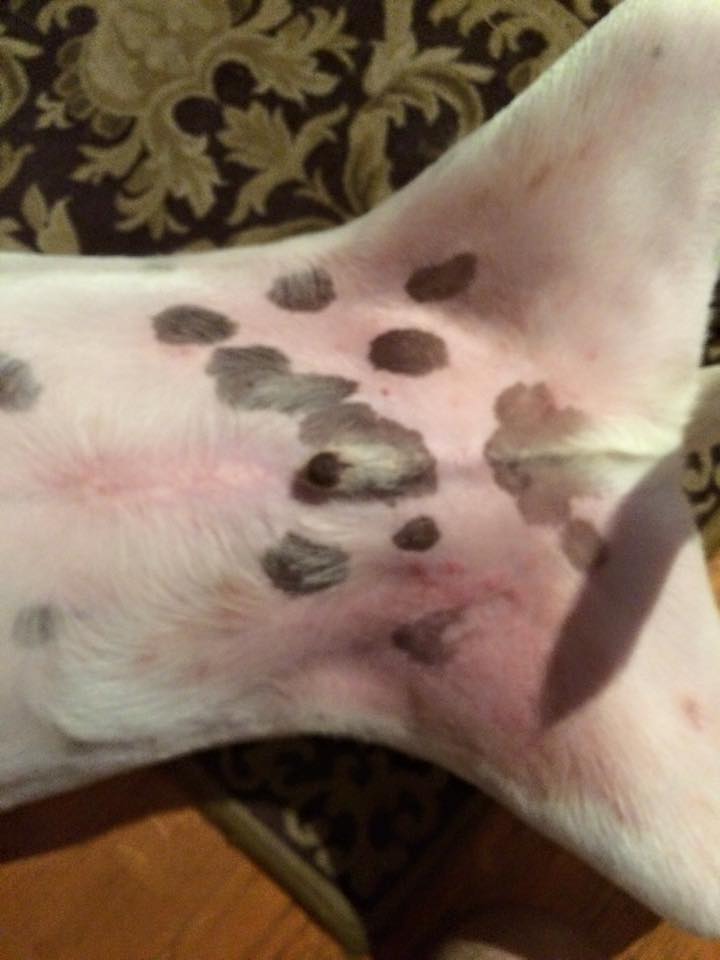
Staph rash gone after SJMO application, same app. time as Delilah.
How is Staphylococcal hypersensitivity treated on dogs?
- “In hypersensitivity cases, long-term control is best achieved with periodic routine injections of Staphylococcal bacterin.”
- Treatment begins the same as for Staphylococcal dermatitis: oral antibiotics, medicated shampoos, and treatment to stop the itching.
- In hypersensitivity cases, long-term control is best achieved with periodic routine injections of Staphylococcal bacterin.
- After the initial series is completed, the injections are given subcutaneously (just below the skin) on an interval ranging from every three to four days to every two weeks.
- These injections frequently will give profound improvement when other treatments have failed.
How successful is this?
Desensitization therapy or “allergy shots” are rarely successful 100% of the time, in dogs or in people. Research has demonstrated that up to 77% of the dogs to respond well.
Most dogs will remain on routine injections for the first one to two years and then less frequent injections may be attempted.
What happens if Staphylococcal bacterin desensitization is not successful?
The dog will require periodic treatment with antibiotics and medicated baths.
This is not the most desirable approach because Staphylococcus will often develop resistance to the antibiotics.
If this occurs, a change in the specific antibiotic used will be necessary. This will also involve more bacteriological tests and antibiotic sensitivity testing in order to establish another appropriate course of treatment.
SJMO oils reference studies using same oils on Dog rashes, infections, parasites, mites, ticks, fleas
Upon researching essential oils that are also in our product, what do the medical journals say? Is there any scientific research to gear for future clinical trials on a more formal level than tests? The ever watchful FDA has a purpose. There are many claims of new cures, or product sales more than actual research. There is a valid reason the FDA regulates quick cures, or products we know take advantage of those concerned medically. We do not do that. We do not make claims of cures, or anything that prescribes medicine. More research is needed, and we always look forward to future clinical trials. Let’s look at what the very hard to find trials have shown success with staph or bacteria, viruses, etc. Below are medical journals from NCBI and PubMed medical journals specifically correlating essential oils effect on above viruses, strains, etc. Our research is comparing the oils specifically from St. Jude’s Miracle oilTM (peppermint, eucalyptus, lavender, geranium, clary sage, clove bud, myrrh, and frankincense and wintergreen) and effect on viruses, MDR, MSSA, MRSA, bacteria, staph and others.
Eucalyptus
Research has shown eucalyptus oil used as herbal gel has had a therapeutic efficacy on skin rashes for dogs1.
Eucalyptus oil has Anti-nociceptive (lower pain stimuli) and anti-inflammatory effects2.
Ectoparasites (fleas and other skin parasites) in dogs) can be transmitted dog to dog, trees, environment. General treatments such as Flea collars, shampoos and powders are not suggested as in the past. Lice generally has spot on treatments similar to flea treatment and is generally a 4-8 week time, including treatment of house, cars, etc.. Ticks should be removed properly and if removed with jaw area still intact, the tick can regurgitates blood possibly causing infection. Mites are spot on treated, or medicinal shampoos.3
Another application that may be of interest to livestock producers is as a treatment for ectoparasites and non-specific skin infections. Two experimental herbal mixtures (AV/EPP/14 and AV/AAGD/14 produced by Dabur Ayurvet Limited in India), which contain Eucalyptus globulus oil along with several other plant oils, have been tested on dogs to treat ectoparasites, fungal skin infections, and non-specific skin infections. While the mixtures appear to be effective, no comparative treatments were used in the studies. (Agrawal 1997 and Bhilegaonkar and Maske 1997).4
And acaricidal effect of Pelargonium roseum and Eucalyptus globulus essential oils against adult stage of Rhipicephalus (Brown tick), immersion in a 5% solution.%.5
Data is from research studies on essential oils and ectoparasites.6
Eucalyptus antibacterial effect against multidrug-resistant (MDR) bacteria.7
Antibacterial effect of essential oils from two medicinal plants against Methicillin-resistant Staphylococcus aureus (MRSA).8
Geranium
Gentle and safe, antifungal. Good for skin irritations, fungal ear infections. Effective in repelling ticks.1
In vitro contact assays using the dog ear mite, Otodectes cynotis (Hering) (Astigmata: Psoroptidae), found that the essential oil constituent, geraniol, killed all mites within 1 h at concentrations of ≥5% (v/v). (NOTE: Geraniol is a monoterpenoid and an alcohol that occurs in small quantities in geranium).2
Engorged adults of Rhipacephalus spp. immersed in 5% essential oil of geranium (Pelargonium roseum) (Pirali-Kheirabadi et al., 2009) were found to have mortalities of 79.2% after 24 h and 83.3% after 48 h, respectively, and a significant decrease in the egg mass laid by female Rhipicephalus was observed after immersion in the essential oils of geranium (Pirali- Kheirabadi et al., 2009).3
Studies show Geranium antimicrobial susceptibility of Staphylococcus pseudintermedius from dogs.4.
Patchouli, tea tree, geranium, lavender essential oils and Citricidal (grapefruit seed extract) anti-bacterial activity.5
Antimicrobial activity of geranium oil against clinical strains of Staphylococcus aureus.6
Clove
Antifungal activity of the clove essential oil from Syzygium aromaticum on Candida, Aspergillus and dermatophyte species.1
Lavender
Lavender effect against MSSA and MRSA.1
Lavender against antibiotic-restistant bacteria.2
Lavender oil, petigrain oil, clary sage oil, ylang ylang oil and jasmine combination against Staph.3
Myrrh
Black pepper, cananga, and myrrh oils have potential against Staphylococcus aureus.1
Myrrh antibacterial, antifungal activity against pathogenic strains E coli, Staph, Pseudomonas and Candida.2
Frankincense
Frankincense (Boswellia serrata) effective against Staphylococcus.1
Wintergreen
Wintergreen acts as an anti-inflammatory and antimicrobial agent.1
Peppermint
(Including Eucalyptus, Lavender, Clove Bud, Peppermint) effective antiseptic topical , Lavender, Clove Bud, PeppermintAtta, A.H. and A. Alkofahi. 1998. Anti-notreatment for MRSA and antimycotic-resistant Candida species.1
The battle against multi-resistant strains: Renaissance of antimicrobial essential oils as a promising force to fight hospital-acquired infections.2
William Vandry
References
Eucalyptus
1.Atta, A.H. and A. Alkofahi. 1998. 2.Anti-nociceptive and anti-inflammatory effects of some Jordanian medicinal plant extracts. Journal of Ethnopharmacology, 60 (2): 117-124. (http://www.ncbi.nlm.nih.gov/pubmed/9582001)
3.http://www.willows.uk.net/general-practice-service/pet-health-information/ectoparasites-in-dogs
4.Bhilegaonkar, N.G. and D.K. Maske. 1997. Efficacy of a herbal compound AV/EPP/14 against ectoparasites of dogs. Indian Veterinary Journal, 74 (10): 869-870 http://www.ansci.cornell.edu/plants/medicinal/eucalyp.html
5.Pirali-Kheirabadi, K., Razzaghi-Abyaneh, M. & Halajian, A. (2009) Acaricidal effect of Pelargonium roseum and Eucalyptus globulus essential oils against adult stage of Rhipicephalus (Boophilus) annulatus in vitro. Veterinary Parasitology, 162, 346–349. 6.http://onlinelibrary.wiley.com/doi/10.1111/mve.12033/pdf From research studies on essential oils and ectoparasites.
7.http://www.ncbi.nlm.nih.gov/pubmed/21591991
8.http://www.ncbi.nlm.nih.gov/pubmed/19576738
Geranium
1.http://www.natural-dog-health-remedies.com/essential-oils-for-dogs.html
2.Perrucci, S., Cioni, P.L., Flamini, G., Morelli, I. & Macchioni, G. (1994) Acaricidal agents of natural origin against Psoroptes cuniculi . Parassitologia (Rome), 36, 269–271. Perrucci, S., Macchioni, G., Cioni, P.C., Flamini, G., Morelli, I. & Taccini, F. (1996) The activity of volatile compounds from Lavandula angustifolia against Psoraptes cuniculi . Phytotherapy Research, 10, 5–8.
3.Pirali-Kheirabadi, K., Razzaghi-Abyaneh, M. & Halajian, A. (2009) Acaricidal effect of Pelargonium roseum and Eucalyptus globulus essential oils against adult stage of Rhipicephalus (Boophilus) annulatus in vitro. Veterinary Parasitology, 162, 346–349.
4.In vitro evaluation of topical biocide and antimicrobial susceptibility of Staphylococcus pseudintermedius from dogs (Geranium safe), 1Departments of Clinical Studies and Pathobiology, Ontario Veterinary College, University of Guelph, Guelph, Ontario, Canada Valentine BK1, Dew W, Yu A, Weese JS. http://www.ncbi.nlm.nih.gov/pubmed/?term=geranium+oil+canine+dogs
5.http://www.ncbi.nlm.nih.gov/pubmed/15555788
6.http://www.ncbi.nlm.nih.gov/pubmed/?term=8.+Antimicrobial+activity+of+geranium+oil+against+clinical+strains+of+Staphylococcus+aureus
Clove
1.http://www.ncbi.nlm.nih.gov/pubmed/?term=Antifungal+activity+of+the+clove+essential+oil+from+aromaticum+on+Candida%2C+Aspergillus+and+dermatophyte+species+Euge%C2%B4+nia+Pinto%2C1+Lu%C4%B1%C2%B4s+Vale-Silva%2C1+Carlos+Cavaleiro2+and+L%C4%B1%C2%B4gia+Salgueiro2
Lavender
1.http://www.ncbi.nlm.nih.gov/pubmed/19249919
2.http://www.ncbi.nlm.nih.gov/pubmed/25174508 3.http://www.ncbi.nlm.nih.gov/pubmed/?term=lavender+oil%2C+petigrain+oil%2C+clary+sage+oil%2C+ylang+ylang+oil+and+jasmine+combination+against+Staph
Myrrh
1.http://www.ncbi.nlm.nih.gov/pubmed/?term=Black+pepper%2C+cananga2C+and+myrrh+oils+have+potential+against++Staphylococcus+aureus
2.http://www.ncbi.nlm.nih.gov/pubmed/10865454
Frankincense
1.http://www.ncbi.nlm.nih.gov/pubmed/?term=Frankincense+(Boswellia+serrata)+effective+against+Staphylococcus
Wintergreen
1.http://www.ncbi.nlm.nih.gov/pubmed/21555977
Peppermint
1.http://www.ncbi.nlm.nih.gov/pmc/articles/PMC2957173/Essential oils Eucalyptus, Lavender, Clove Bud, Peppermint
2.http://www.ncbi.nlm.nih.gov/pubmed/19473851
